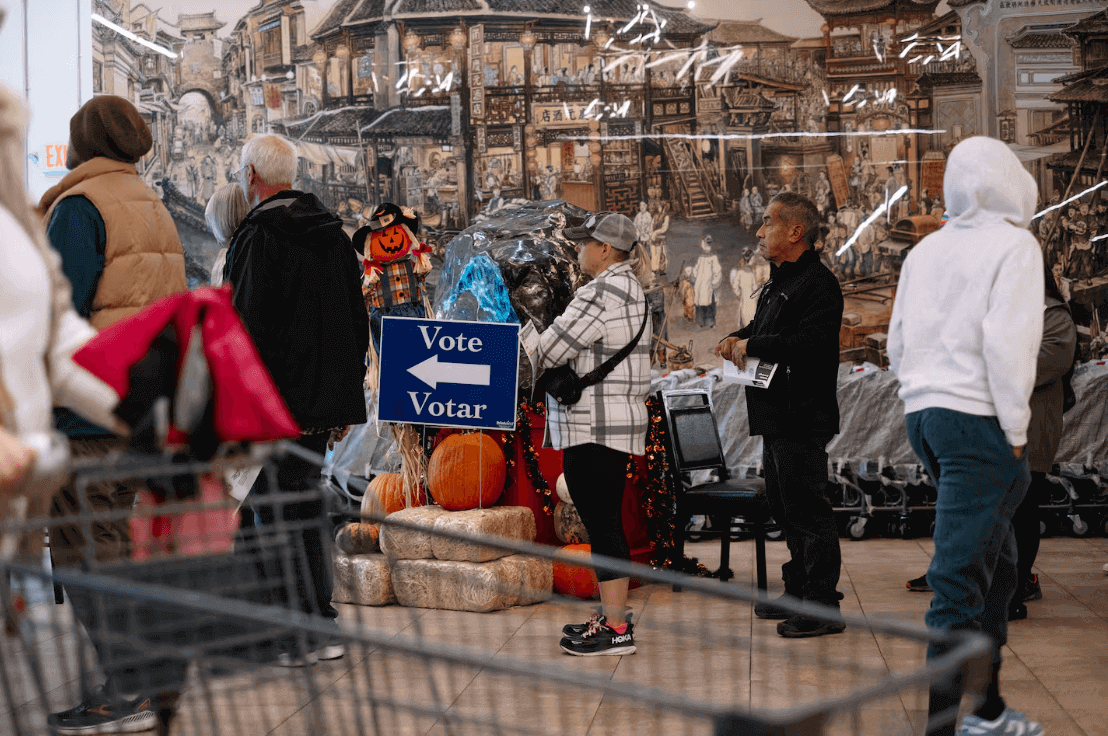疲惫、不安和紧张:美国人蜂拥参加提前投票

【中美创新时报2024 年 11 月 4 日编译讯】(记者温友平编译)焦虑的美国厌倦了激烈的竞选季,担心国家的民主状况,他们坚定地投票,大约有 7500 万人在提前投票期间投了票。
《纽约时报》记者尼克·科拉萨尼蒂对此作了下述报道。
在北卡罗来纳州,在飓风海伦造成的破坏中,近 450 万选民创下了该州提前亲自投票的记录。佐治亚州选民也创下了 400 万选民提前投票的记录。在宾夕法尼亚州,170 万人通过邮寄投票,而关于谁的邮寄选票应该计入的诉讼日益激烈。九个州已有超过 50% 的合格选民投票。
佛罗里达大学政治学教授迈克尔·麦克唐纳 (Michael McDonald) 负责跟踪投票情况,根据提前投票的预测,今年大选的总体投票率可能介于 2016 年约 60% 的合格选民和 2020 年三分之二的合格选民之间。虽然总体投票率可能略低于 2020 年大选创下的现代最高水平,但与几乎所有往年相比,美国仍有望创下历史新高。
随着美国进入近年来政治史上最重要的一周,大批美国人对选举过程的几乎每个方面都感到紧张,全国各地的官员都在竭尽全力支持选举,包括引入新的安全保护措施。

他们的大部分担忧源于 2021 年 1 月 6 日在国会大厦举行的 2020 年总统竞选的暴力高潮。今年,前总统唐纳德·特朗普 (Donald Trump) 按照熟悉的套路行事,散布有关选举的谎言,并声称民主党是“一群骗子”。
选举官员面临着一些重大考验。宾夕法尼亚州一个关键县未能向选民投递数千张邮寄选票,而该州另一个县被发现在截止日期前错误地拒绝了选民。佐治亚州发现了俄罗斯的干涉。科罗拉多州选举机器的部分密码被泄露。
然而,官员们指出,这些问题很快就被发现和解决了,这表明该系统正在发挥作用。宾夕法尼亚州的这些县增加了提前投票的额外天数。选民受到恐吓或骚扰的报道很少见,等待投票的人排得太长的队也很少见。最后一刻对选民资格的大规模挑战从未发生过。可疑活动虽然很少,但得到了迅速处理。对地方官员的骚扰只是偶发事件,而不是普遍现象。而一连串的诉讼在最后一刻几乎没有扰乱或改变投票规则。
“外面有很多噪音,而且因为噪音很大,所以会受到很多关注,”宾夕法尼亚州共和党国务卿 Al Schmidt 说。“但这不应该阻止任何一位选民投票,无论是通过邮寄投票,如果他们已经申请了,还是在选举日亲自投票。”
尽管如此,在选举日之前,全国仍然紧张不安,在普遍存在欺诈的虚假幽灵中,越来越多的阴谋论活动人士呼吁监视或记录选民。
对七个战场州 40 多名选民的采访显示,选民对一场似乎具有生死攸关意义的选举感到精疲力竭。
“这让人很紧张,”22 岁的拉斯维加斯发型师 Gunner Robblee 描述了提前投票期间在投票站等待的感受。“排队让我充满了期待。每走 10 英尺,我就会出点汗。”
连续第二届总统选举的提前投票率很高,这增加了总统竞选的不可预测性,也揭示了现代政治的一个悖论。有了更多关于谁真正投了提前选票的数据,竞选活动现在可以更容易地根据自己的投票模型了解他们的表现如何,以及在疯狂的拉票活动中他们还需要瞄准哪一小部分选民。
但由于 2020 年大选导致美国人的投票行为发生了巨大变化,所有这些数据基本上都是在历史对比的真空中进行的。那场竞选开启了选举总统的新程序,全面转向提前投票,但那场竞选也是在致命的疫情中举行的,疫情推动了选民的选择。
“那么,邮寄选票中有多少将在选举日进行,选举日又有多少提前转向了现场投票?”麦克唐纳说。“我们不知道,直到选举日才会知道。”
美国大选的这种转变模式让两大竞选团队都试图在提前投票中占据优势。
特朗普竞选团队的提振使共和党的提前投票率大幅提高。在过去两次选举中,民主党将邮寄和现场提前投票转化为投票箱中的明显优势。今年,特朗普竞选团队及其盟友改变了他们的口号,恳求选民提前投票,即使他们对这一前景感到不满意(这种不信任主要是由于特朗普对邮寄投票的多次虚假指控)。
在全国各地,尤其是在宾夕法尼亚州,这一口号正在传播开来。
本月,在匹兹堡市中心的县选举办公室,贝丝·康威和丈夫拉里在一个异常温暖的周六早晨投下了选票。她强忍着泪水。
“这违背了我的一切信念——我都快哭了,”住在宾夕法尼亚州肯尼迪镇的 74 岁的贝丝·康威说。“我对整个事情都感到不安全。实际上,我这样做还是在机器上投票并不重要。我只是向上帝祈祷,我的选票会投给我投票的人。”
77 岁的拉里·康威指出,在选举日亲自投票可能会带来挑战。
“在选举日,人们会说‘机器坏了’、‘我们没有选票了’或‘我们没有选票’,”他说。“这件事有很多陷阱。”
当被问及他们今年为何选择提前投票时,答案很简单。“我在这里投票是因为特朗普竞选团队告诉我们要提前投票,所以我们就这么做了,”贝丝·康威说。
但像康威夫妇这样的人是可靠的共和党选民——无论采用何种方式,他们都有可能投票给特朗普——这让共和党试图宣称的一些提前投票趋势变得复杂。截至周六,在宾夕法尼亚州提前投票的 57 万名共和党人中,超过 40% 在 2020 年选举日投票,这表明共和党的投票行为发生了巨大转变。民主党更广泛地接受提前投票,从选举日到提前投票的转变只有约 12%。
然而,尽管选民们蜂拥到投票站提前投票,尽职尽责,犹豫不决或热切,但一种不安的情绪几乎普遍存在。副总统卡马拉·哈里斯和特朗普的支持者也对他们的候选人可能失败的前景表示了类似的焦虑。
“我很紧张——我只是觉得我不想打仗,”60 岁的戴安娜·理查兹说,她周四在密歇根州迪尔伯恩为特朗普投票。“这是我最大的恐惧之一。”
“哦,这很糟糕,”75 岁的艾琳·麦戈文在密尔沃基市中心为哈里斯投票后说道。当乔·拜登在 2020 年与特朗普竞选时,“我不想醒来,我闭上了眼睛,”她回忆道,不敢看新闻,直到她终于在报纸头版看到“拜登赢了”。
今年她更加担心。“我只是觉得他对这个国家不利,”她谈到特朗普时说道。
本文最初刊登于《纽约时报》。
题图:周日,选民们在威斯康星州麦迪逊市全球市场与食品大厅内的投票站排队。JIM VONDRUSKA/NYT
附原英文报道:
Weary, troubled, and nervous: Americans flood the early vote
By Nick Corasaniti New York Times,Updated November 3, 2024
Voters waited in line at a polling location inside the Global Market & Food Hall in Madison, Wis., on Sunday.JIM VONDRUSKA/NYT
An anxious America, weary from a vitriolic campaign season and worried about the state of the nation’s democracy, is voting with determination, with roughly 75 million people having cast ballots in the early voting period.
In North Carolina, nearly 4.5 million voters set an early in-person voting record in the state amid devastation from Hurricane Helene. Georgia voters also set a record with 4 million voters casting an early ballot. In Pennsylvania, 1.7 million people voted by mail amid increasingly caustic litigation over whose mail ballots should count. Nine states have seen more than 50 percent of eligible voters already vote.
Projections from early voting indicate that the overall turnout for the election will probably be between the roughly 60 percent of eligible voters who turned out in 2016 and the two-thirds of eligible voters who voted in 2020, according to Michael McDonald, a professor of politics at the University of Florida who tracks voting. While overall turnout is likely to be slightly lower than the modern high-water mark set in the 2020 election, it still puts the country on pace for a historical high compared with almost all other previous years.
As the nation enters one of the most consequential weeks in recent political history, with swaths of Americans nervous about nearly every aspect of the electoral process, officials across the country have mounted a furious effort to shore up the election, including by introducing new protections for their safety.
Much of their worry stems from the violent culmination of the 2020 presidential race at the Capitol on Jan. 6, 2021. This year, former president Donald Trump is working from a familiar playbook, spreading falsehoods about the election and claiming that Democrats are “a bunch of cheats.”
Election officials have faced some significant tests. A key county in Pennsylvania failed to deliver thousands of mail ballots to voters, while another county in the state was found to have erroneously turned away voters before a deadline. Russian interference was uncovered in Georgia. Partial passwords for election machines were breached in Colorado.
Yet officials note that the problems were quickly detected and resolved, signs that the system is working. Those Pennsylvania counties added extra days for early voting. Reports of voter intimidation or harassment have been sporadic and rare, as have reports of excessively long lines for people waiting to vote. Last-minute mass challenges to voters’ eligibility never materialized. Suspicious activity, while sparse, was swiftly dealt with. Harassment of local officials was more episodic than widespread. And a blizzard of litigation did little to disrupt or change voting rules at the last minute.
“There’s a lot of noise out there, and because it’s noisy, it gets a lot of attention,” said Al Schmidt, the Republican secretary of state in Pennsylvania. “But that shouldn’t dissuade a single voter from casting their vote, whether it’s by mail, if they’ve applied already, or in person on Election Day.”
Still, the nation remains on edge ahead of Election Day, with increasing calls from conspiracy-minded activists to monitor or record voters amid the false specter of widespread fraud.
Interviews with more than 40 voters in the seven battleground states revealed an electorate exhausted by an election that seems to carry existential weight.
“It’s nerve-racking,” said Gunner Robblee, a 22-year-old hairstylist in Las Vegas, who described waiting at the polls during early voting. “The line filled me with anticipation. Every 10 feet, I broke a little sweat.”
The huge early vote turnout for the second straight presidential election has added to the unpredictability of the razor-thin race for president and revealed a paradox in modern politics. Armed with more data about who has actually cast early ballots, campaigns can now more easily understand how well they are faring based on their own vote models, and which small sliver of voters they still need to target in a frantic get-out-the-vote push.
But all of that data is essentially set against a vacuum of historical comparisons because of the sea change in American voting behavior caused by the 2020 election. That contest set in motion a new process of electing a president, with wholesale shifts to early voting, yet it was also held in a deadly pandemic that fueled voters’ choices.
“So how much of that mail ballot is going to be Election Day, and how much of that Election Day has shifted in-person early?” McDonald said. “And we don’t know, and won’t know until Election Day.”
This shifting pattern in American elections has both campaigns trying to claim the momentum in early voting.
Buoying the Trump campaign has been a vast improvement in early vote numbers for Republicans. For the past two elections, Democrats turned early voting, both through the mail and in person, into a distinct advantage at the ballot box. This year, the Trump campaign and its allies have shifted their message, pleading with their voters to cast ballots early even if they are not comfortable with the prospect (a distrust largely caused by Trump’s many false accusations about voting by mail).
Across the country, and especially in Pennsylvania, the message is landing.
At the county elections office in downtown Pittsburgh this month, Beth Conway dropped off her ballot with her husband, Larry, on an unusually warm Saturday morning. She was fighting back tears.
“This goes against everything I believe — I’m ready to cry,” said Beth Conway, 74, who lives in Kennedy Township, Pa. “I just feel not secure with the whole thing. It doesn’t matter, really, if I go do it this way or I do it on a machine. I just pray to God that my vote is going to be for who I voted.”
Larry Conway, 77, noted that voting in person on Election Day can come with its challenges.
“On Election Day, it’s ‘The machine’s not working’ or ‘We’re out of ballots’ or ‘We didn’t get ballots,’” he said. “There’s so many pitfalls to this thing.”
Asked why they chose to cast an early ballot this year, the answer was simple. “I voted here because the Trump campaign is telling us to go do it early, so that’s what we’re doing,” Beth Conway said.
But people like the Conways were reliable Republican voters — likely to vote for Trump regardless of the method — which complicates some of the early vote trends Republicans are trying to claim. More than 40 percent of the 570,000 Republicans who cast an early ballot in Pennsylvania as of Saturday voted on Election Day in 2020, showing a big shift in Republican voting behavior. Democrats, who more widely embraced early voting, only saw about a 12 percent shift from Election Day to early voting.
Yet while voters flocked to the polls to vote early, dutifully, hesitantly, or eagerly, a skittish sensibility was near universal. Supporters of Vice President Kamala Harris and Trump expressed similar anxiety about the prospect that their candidate might lose.
“I’m nervous — I just feel like I just don’t want to go to war,” said Diana Richards, 60, who cast a ballot for Trump in Dearborn, Mich., on Thursday. “That’s one of my greatest fears.”
“Oh, it’s bad,” said Erin McGovern, 75, after she cast her ballot for Harris in downtown Milwaukee. When Joe Biden ran against Trump in 2020, “I didn’t want to wake up, I had my eyes closed,” she recalled, afraid to watch the news until she finally saw “Biden won” on the front page of a newspaper.
This year she is even more concerned. “I just think he is bad for the country,” she said of Trump.
This article originally appeared in The New York Times.

